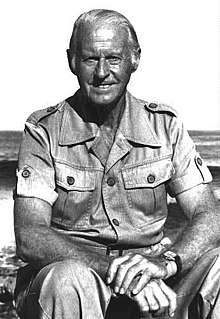Jakten på Odin
The Search for Odin (Norwegian: Jakten på Odin) is the project title of Thor Heyerdahl's last series of archaeological excavations, which took place in Azov (Tanais) in Russia.
Theoretical background
Heyerdahl's intention was to prove the veracity of the account of Snorri Sturluson in the Ynglinga saga, written in the 13th century, about the origin of the Norse royal dynasties, and the pre-Christian Norse gods. Snorri provides a euhemeristic account, in which he describes the Norse god Odin and some other Norse gods, the Æsir, as having been real people who emigrated from the area around the river Don to Scandinavia at the time of the Roman expansion into their old homeland. In Scandinavia, Snorri writes, they so impressed the native population that they started worshipping them as gods.
Heyerdahl tried to seek the origins of the Æsir, following the route set out by Snorri Sturluson in the Ynglinga saga, from the Black Sea and the river Tanais (referred to by Snorri Sturluson by the names Tanaís and Tanakvísl[1]) via Saxon homelands in northern Germany, Odense on Fyn, Denmark to Old Sigtuna, ancient Sweden. When Heyerdahl died in 2002 the second season of excavations had just been finished.
Critique
Heyerdahl's Odin project was subjected to fierce criticism from Norwegian academics within the fields of research upon which the theory touches. Both the first book detailing the Odin project, Ingen grenser from 1999, and the second book, Jakten på Odin from 2001, were met with a forceful and detailed response from leading academics in which the reasons were laid out to the wider public as to why Heyerdahl's theory in their view was false. After the last book the attacks against Heyerdahl were also worded in a way that by many was seen as disrespectful.[2] The five leading academics responsible for the reviews explained that although popular literature would not normally be subject to such scrutiny, they felt it was necessary in this case, partly because Heyerdahl himself laid claim to academic credentials and partly due to his popularity.[2]
The reviewers, speaking on behalf of the academic community of Norway, categorize Heyerdahl's theory as an example of pseudoarchaeology, based on a selective reading of sources, and a lack of understanding, or a lack of willingness to use basic scientific methodology. Much of the foundation of his theory, they point out, is based on similarities between names of figures from Norse mythology and geographical place-names of the present time in the Pontic steppe and Caucasus. Comparison of these names is done with disregard of linguistic theory, according to the reviewers.[3]
Azov is believed by Heyerdahl to have derived its name from as-hof – temple of the Æsir. Mainstream linguists and historians will say that the city of Azov got its name from the Turks, over 1000 years after Heyerdahl believes the Æsir lived there. Heyerdahl also points to the similarities between the word Æsir and the Azeri and Ossetian peoples of the Caucasus, between the god Odin and the Caucasian language group Udi and between the god Tyr and Turkey, and between the Vanir (a group of Norse gods) and the word Vannic, which was for a time in the 19th and 20th centuries the name used for the Urartian language, spoken in ancient times in the area around Lake Van.
The linguists and historians behind the review point out that there is no reason to believe that these similarities are any more than coincidences. In particular, they point out that Heyerdahl makes no attempt to look at the development of languages – he anachronistically compares modern day forms with ancient ones. For instance, diachronic linguists will say that the god Odin was called Wōdanaz 2,000 years ago, which no longer looks so similar to Udi. Similarly, they assert that his hypothesis fails to explain why there should be any relation whatever between antiquity/medieval Germanic names, and names that are to be attributed to extremely distant languages, if those be Indo-European at all (as Turkish and Caucasian languages have no relation whatever to Germanic, while Ossetic at least is Indo-European, although from the Indo-Iranian family). However, others like Swedish Professor Åke Daun[4] say that the Turkic Huns were the ruling elite of the Goths.
See also
References
- ↑ Wikiheimild: Heimskringla - Ynglinga saga: 1. Hér segir frá landaskipan
- 1 2 "[...]mange har oppfattet den som nedsettende", one of the five reviewers, Anne Stalsberg, wrote in the article 'Ytringsfrihet og påstått vitenskap – et dilemma?'
- ↑ Even Hovdhaugen, Christian Keller, Else Mundal, Anne Stalsberg, Gro Steinsland: Anmeldelse av Thor Heyerdahl og Per Lillieström: Jakten på Odin. Stenersens forlag. Oslo 2001. Maal og Minne 1 (2002) s. 98-109.
- ↑ http://www.popularsocialscience.com/2013/01/08/never-marry-a-swede/
Further reading
The background for the project is described in two books, Ingen grenser, 1999, Heyerdahl, Thor and Per Lillieström, Oslo: Stenersens forlag, ISBN 82-7201-270-7 and Jakten på Odin—På sporet av vår fortid, 2001, Heyerdahl, Thor and Per Lillieström, Oslo: Stenersens forlag, ISBN 82-7201-316-9.
External links
- Bjornar Storfjell's account: A personal account of an anthropologist who worked with Thor Heyerdahl. Azerbaijan International, Vol. 10:2 (Summer 2002), p. 25. "Thor Heyerdahl's Final Projects."
- Maal og minne 1, 2002: Review of Heyerdahl's book 'Jakten på Odin. På sporet av vår fortid' (2001), by Even Hovdhaugen, Christian Keller, Else Mundal, Anne Stalsberg and Gro Steinsland. (In Norwegian.)
